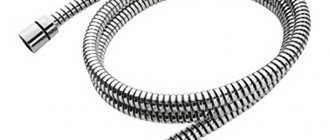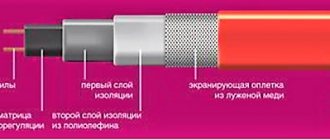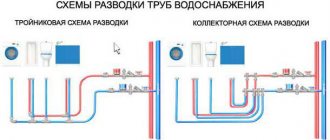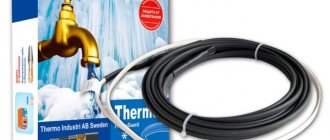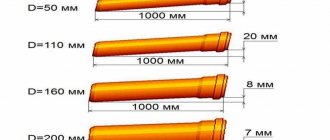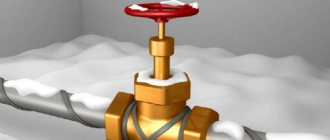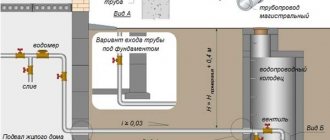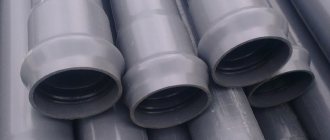If you have a summer house or live in a private house, then you have probably encountered the problem of freezing of various wires and pipes. Fortunately, to eliminate this problem there is a so-called heating cable. Its advantage over other methods of solving a similar problem is that its installation is quite cheap and very understandable even for those who have never encountered or solved this type of problem.
Protect your home from freezing
What is a heating cable, how does it work?
Heating of external pipelines is very common in many regions of Russia. A heating cable for water supply can be installed both inside and outside the pipe, and is essentially a simple wire. And due to the presence of resistance, one of the capabilities of a metal conductor is used - by passing an electric current through itself, the metal has the ability to heat up.
As the current increases or decreases, the temperature of the cable increases or decreases accordingly. Thus, the presence of these physical properties makes it possible to regulate the temperature norm.
Accordingly, the higher the resistance level, the more the device heats up. It is clear that the self-regulating electrical wire must be protected by good waterproofing, because it is located in water.
Turn on the heating cable at a temperature of + 5 degrees inside the water supply. As the ambient temperature decreases, the resistance on the wire increases, thus maintaining the desired water temperature in the water supply.
This cable can be purchased in various lengths. These can be species from two to twenty meters. They allow you to heat part of the water supply with a wire, or the entire main if it is located in a freezing zone.
Watch the video
At first glance, such a cable seems to be a very simple device that you can install with your own hands and effectively heat the water supply. But, in order to correctly select and install the heating cable inside the pipe, you must carefully study all the information that will be presented below.
Heating cable into the pipe from the manufacturer
Self-regulating cable SAMREG 17HTM2-CT
- Power: 17 W
- Purpose: pipeline / inside the pipe
- Type: self-regulating
- Type: low temperature
- Application: without explosion protection
- Max. temperature (operating): 65 °C
Self-regulating cable SRL 17HTM2-CT
- Power: 17 W
- Purpose: pipeline / inside the pipe
- Type: self-regulating
- Type: low temperature
- Application: without explosion protection
- Max. temperature (operating): 65 °C
Self-regulating cable ALPHATRACE ATMI-CF11
- Power: 11 W
- Purpose: pipeline / inside pipe / tank
- Type: self-regulating
- Type: low temperature
- Application: explosion-proof
- Max. temperature (operating): 65 °C
To section
Let's consider the design of heating electrical wires
The heating cable for pulling inside the network is produced in the form of a strip electric heater. In the context of the heating device, it has the following components:
- Metal conductor for heating.
- Heating electric cable cores covered with heat-resistant PVC (polyvinyl chloride) insulation.
- The inner layer of insulation is covered with fluoroplastic protection.
- All conductors are enclosed in a screen in the form of a copper mesh.
- The last outer layer of insulation on the heating device is also made of heat-resistant PVC coating.
The outer insulation layer on the heating cable has the following characteristics. It is resistant not only to the influence of moisture and high temperature, but is absolutely not afraid of exposure to aggressive chemical environments.
Also, the warm cable for pulling inside the water supply system is made from materials whose composition is approved for use in the food industry. Therefore, it can be installed in the drinking water pipeline.
In addition, the heating cable is equipped with a temperature regulator, as a result of which it becomes self-regulating and gains the ability to independently set the temperature regime. This allows you to control the temperature inside the water supply without human intervention. If the temperature exceeds the specified parameters, the system is turned off automatically. These features of the device help prevent overheating and save energy.
A heating cable for installation inside a pipe has the following advantages:
- Reliable performance.
- High security.
- Possibility of using a heating cable both internally and externally.
- Easy installation and operation.
- The ability to save energy through automation is a self-regulating ability.
Perhaps the only drawback of these heating units is their dependence on electricity. For these reasons, it is recommended to install additional power supplies along the main pipeline routes.
What is a self-regulating cable
A self-regulating cable is a unique invention, which is a flexible wire that heats up under the influence of electricity. At the same time, it has the ability to regulate its own power, focusing on the ambient temperature. That is, the colder the atmosphere, the hotter the self-regulating cable. It seems to adapt to the characteristics of its environment, and not along its entire length.
The principle of operation of a self-regulating heating cable lies in its internal arrangement. Roughly speaking, it consists of three main parts:
Multi-layer construction provides unmatched protection and impact resistance
- Metal conductors – provide electricity supply;
- “Smart” polymer matrix – it is this that adapts to changing conditions and generates heat;
- Insulation – a whole “sandwich” of several materials is used here.
The key link here is the polymer matrix. It is she who is responsible for self-regulating properties. Moreover, literally every centimeter of it lives its own separate life.
That is, one segment may be colder or, conversely, hotter than another. And all this without any electronics, without any sensors and everything else - just a polymer base made of “smart” material.
The self-regulating heating cable for water supply has another interesting property - it is of arbitrary length. We can take strong scissors, cut it and plug it back in - it will work as if nothing had happened. Literally every millimeter works here, so its length does not really matter. Unlike the New Year's garland, it will continue to work even if it accidentally breaks. However, the self-regulating heating cable has a fairly robust design that prevents emergency breaks.
Other properties of the self-regulating heating cable:
The “smart” polymer in the cable itself regulates power consumption, which allows you to significantly save electricity
- High mechanical strength - it runs on electricity, which means that it needs strong multi-layer insulation;
- Resistance to moisture - it works quietly in the water column. The main thing is to insulate its end part using a special shrink film;
- Efficiency in energy consumption - ensured due to self-regulating properties (up to complete shutdown).
The strength of the self-regulating heating cable is ensured by its multilayer nature. The first two layers are copper conductors and a “smart” polymer. An insulating layer of polyolefin or fluoropolymer passes over them.
The next layer plays the role of armor - copper braiding is used here. Our “sandwich” is completed by another layer of polyolefin insulation. Thanks to this design, the self-regulating heating cable is very durable and durable.
The copper braid simultaneously acts as protection against electromagnetic radiation - it is weak, but still there.
Types of heating cables – resistive and self-regulating
Internal or external heating of the pipeline depends on the method of heat generation and is performed by the following types of devices. 1. Resistive - consist of one or more metal wires. Due to the complexity of installation, single-core ones are used much less frequently. The difficulty lies in the fact that it is necessary to loop the circuit around the power source, and this is not always possible.
Two-wire - at one end we connect to the power source, at the other, to ensure the circuit is closed, we install a contact coupling.
Either one core can heat up (the second only provides conductivity) or two. In the latter case, the power becomes much higher.
2. Self-regulating – heating cable designed for installation both inside and outside the water supply system. The operating principle is similar to the previous type of device. A distinctive feature is the ability to independently regulate the level of heat supply when the temperature changes, resulting in significant savings in electrical energy consumption.
For these reasons, it is excellent for installation on small sections of the highway. It is not necessary to install a thermostat. Self-heating cable-type devices come not only with a thermostat, but also with various elements for installation and special seals - adapters for pulling inside the water supply.
Self-regulating heating cable has become more widespread. The disadvantages include its high cost.
Heating cable for water supply outside or inside the pipe - installation features
A heating or heating cable inside the pipe is installed if the water supply system is already in use and freezes when severe cold occurs. This cable is installed inside the pipe through a gland.
An important nuance is that if the heating cable is installed outside the pipe from above, then additional fixation is not required. If the heating element is installed from below, then it must be securely fixed to prevent it from slipping.
If you plan to heat a pipe through which drinking water passes, then the sheath of such a wire must be made of a polymer that meets all food safety parameters.
Installation of a self-regulating cable inside the pipe from above
To install the cable inside, accurate measurements of the length of the section of water supply that needs heating are required. The heating cable must be inserted into the pipe very carefully to avoid damage to the protective sheath. Cables are not routed through shut-off valves.
The cable is secured over the pipe using aluminum adhesive tape (regular tape cannot be used). During the installation of the heating cable, it is necessary to ensure that the wire is not pinched, stretched, or chafed by sharp elements. First, the electrical cable is attached to the pipe with separate pieces of aluminum tape, and then more radically, along the entire length.
Installing a heating cable over a pipe
If the pipe is plastic, then before installing the cable it would be useful to cover it with aluminum tape or foil. The thermostat sensor, coupling, heating section and other additional elements are also attached using aluminum tape.
Selecting a cable by power and manufacturer
Internal self-heating cable for heating water supply according to type of use is divided according to power indicators.
The power indicator depends on the following parameters - the average annual temperature of the region, the method of laying the pipeline (external, internal) and its insulation, how the heating will be carried out - inside the pipe or outside. The diameter of the pipe will also be an important factor.
When purchasing a heating cable for a water supply system, you must ask the seller to provide information on cable consumption per 1 meter of pipeline (provided by the manufacturer for each power).
For use in a short household line, it is better to install a low-power heating kit. For example, for a country house and cottage, a power of 5 to 25 W/m is used for heating. But again, everything is individual here.
The amount of heat loss depends on the volume of the pipe and the quality of the insulating layer. So, for example, a 50 mm metal pipe with 20 mm insulation is effectively heated by a device with a power of 20 W/m.
A high-power cable system is installed on an important main line for heating. Before installing such a system, you should know that the power in the heating wire is selected in accordance with the diameter and length of the main line. But, the energy consumption for heating in this case will be noticeable.
Watch the video
The most popular among specialists are the products of “Raychem” (Germany). This trade line is represented by a variety of models that are used not only in industrial enterprises, but also in household pipelines.
Any cable set that this manufacturer offers has a higher price than similar options from other manufacturers. But this is fully compensated by the quality of the products.
Professional craftsmen also include Russian ones in their line of high-quality products, which quickly gained popularity among consumers.
The “Underlux” pipe heating kit made in Germany deserves special attention. This kit, which is intended for installation within the network, is most often used in everyday life.
This system has received an expert opinion on hygienic safety, which is evidence that it is allowed to be installed in the network supplying drinking water. The heating temperature of the “Underlux” kit along its entire length is under constant control.
Installing Underlux products is not difficult. This is done using fittings made by casting. The main advantage of this self-regulating device is the ability to independently change operating parameters, depending on the ambient temperature.
This advantage ensures long and reliable operation. The kits provided by this manufacturer are characterized by high operating efficiency and the ability to save energy. They can be installed in the water supply and drainage systems, in gutters, etc.
The review of various manufacturers can be continued for a long time. The main thing to do when choosing is to carefully study the pros and cons of the proposed options. Also, each model comes with instructions from the manufacturers. It also needs to be carefully studied before work.
Watch the video - insulating the water supply from the trench to the house
You can buy a good and high-quality product from many manufacturers, but it is better to contact a trusted company. If difficulties arise in determining the amount of wire to be purchased, then consultants will help you make this calculation.
They will also help you choose the right product at a reasonable price. By the way, it must be added that the best place to buy electrical wire for pipes is the Leroy Merlin construction hypermarket. There is always a large selection of products of high quality and reasonable prices.
Proper use of heating cables for plumbing
No, even good (modern) heating cables without a thermal relay are suitable for long-term, reliable and economical operation, including “Samregi”
"Samregi"
“Samreg” or self-regulating cable is designed to heat pipes from freezing water in them. They are hooked close to the pipes outside (or inside the pipes), thermally insulated, and plugged into the network, and then they warm the pipes and prevent the water from freezing in them.
Characteristics
The fact that “Samreg” is a self-regulating cable is cheap advertising. Andrey tested one of the best Nelson LT cables at t=0°C and at t=10°C the difference in power consumption is only 15%.
Those. - when the temperature (water) rises to a value where heating is no longer necessary (plus 10°C), the cable continues to heat and wastes both the cable resource (and these cables are far from eternal) and electricity (only 15% less than at zero). Andrey studied the characteristics of some other heating cables (“samregs”) - they are not fundamentally different.
Conclusions Any heating cable must be equipped with additional shutdown subsystems, for example, a thermal relay (also known as “thermal sensors”).
Below, Andrey, a member of the “House and Dacha” forum, will tell you how to properly assemble heating systems for plumbing
If a heating cable for a water supply is installed on top of a pipe going from the ground to the house, then replacing it if it fails becomes a big problem. Even if this problem is easily solved (for example, with a cable inside a heated pipe), the reliability of this system (especially in cold weather) still has a very high priority.
In the winter of 2009-2010, a huge number of people's water pipes froze. Therefore, he takes maximum durability of the heating system as his goal.
The heating cables themselves have limited durability, so if you turn them on as little as possible, their life will increase accordingly. Electricity consumption also matters (especially when the heating is constantly on). the main idea
If the temperature of the pipe is close to the t temperature of the water in the well or well, then this means that there is no point in heating it, or rather, it is even harmful. Therefore, the cable disconnect temperature should be slightly less than the winter (lowest) water temperature in your well/well.
How to make the “correct” pipe heating system
In winter (at the very coldest) the water in a well or well has a temperature t. For clarity, let’s take it equal to 5 degrees. We take a high-quality, durable heating cable (it doesn’t matter whether it’s “samreg” or not, the main thing is its lifespan and a sufficiently large number of on-off switches), lay it along the pipe as expected. There, close to the pipe in its coldest place (perhaps this is at the lower quarter of the distance between the ground and the floor of the house), we install a thermal relay sensor, and on the thermal relay itself (located in the house) we set the on t of 2-3 degrees and the off t of 3- 4 degrees.
We thermally insulate the entire pipe (together with the sensor) with insulation with a thickness of at least 20mm (in general, the more, the better for your wallet in the future). And we correctly connect all this to the 220V network.
The result was the most optimal option for a heated pipe based on the criteria of electricity consumption and cable life. When using an internal heating cable, nothing fundamentally changes.
If you use a cable without a thermal relay (including “samreg”), then the result is an overconsumption of both energy and cable resource. Moreover, many times compared to the method described above. About choosing the power of the heating cable
Andrey didn’t understand this, but if you do everything “correctly,” then, in his opinion, saving on power is almost pointless. If the cable is mounted inside the pipe, then 10 W/m is enough to heat it, and if outside, then 17 W/m. About the thermostat and temperature sensor
Ideally, you need a small sealed sensor with a digital thermostat located in the house. If we do not take reliability into account, then the following would be ideal: the TR-35M thermostat, or the TSTAB thermostat. Both are designed for DIN rail.
What not to do
- For example, there is no need to use Nelson EasyHeat Resistive Cable to heat a pipe leading from a well or well into a house. Why? Because here the cable will turn off only at +13 degrees. And in the wells such a high temperature, according to Andrey, never happens. This means that the cable will always be on! And turning it off manually, for example, in the spring, risks freezing the pipe on a cold night.
- The temperature sensor should not be installed in close proximity to the heating cable, otherwise the system will not work properly. It must be placed on the side of the pipe opposite to the heating cable, and carefully insulated from the heating cable (but not from the pipe).
- You should not use insulation that can get wet (cotton wool), and you should not let the earth compress the insulation. In either of the two cases, it will almost cease to insulate. You can use, for example, foamed polyethylene with a rigid pipe on top. For example, you put a standard “stocking” on a pipe with a diameter of 30-50 mm and put it all into a sewer pipe with a diameter of 110 mm.
Monitoring system performance
The presence of a “heating” LED on the thermostat is important for monitoring the operation of the entire heating system - on a frosty morning in winter, before the first use of water, the “heating” light should, in theory, be on, and after using a large volume of water, it may go out for a while. This means the system is working correctly.
Also, by temporarily changing the on/off temperatures of the thermal relay (“adjusting” them to the temperature of the pipe), you can observe the on/off of this indicator.
Andrey claims that his theory is confirmed by eight years of practice using the system.
Posted by a member of the “House and Dacha” forum Andrey Editor: Adamov Roman
Cable prices
The price of a heating cable kit is influenced by a number of factors:
- length of the heating product;
- equipment;
- the cost of the gland, which is necessary to insert the thermal cord into the water supply;
- model of power cord with plug;
- sockets;
- price list for assembly services of all components.
The average price per meter of thermal cord is 440 rubles. The cost of an adhesive kit for connecting a structure starts from 350 rubles. The minimum price for oil seals is 420 rubles. A two-meter power cord with a molded plug can be purchased for 200 rubles. For the service of assembling the entire kit you will have to pay at least 500 rubles.
Heating cables are sold in specialized stores, where you can choose the right size. In addition, it is possible to place an order for courier delivery of the finished product from companies that sell these products by phone or online.
For your information! To reduce the amount of energy consumed when using a cable for heating a water supply, the size of which is more than 3 meters, it is recommended to use it with a thermostat sensor.
Installation methods for water supply
The main area of application of a heating thermal cable is the protection of pipelines, for which in practice two installation methods are used - external and internal. Both methods do not require special qualifications and can be done with your own hands.
Outer
You can lay the heating cable on the outer wall along the pipe or in a spiral, wrapping it around it. In both cases, the method and pitch of fastening, the pitch of cable winding must comply with the manufacturer's instructions.
The first method is more suitable for heating a small diameter water pipe. For main lines and large sewer collectors, the second method is suitable. With this method, heating is more uniform, but the consumption of electricity and material is higher.
Interior
This method is used for pipes with a diameter of at least 40 mm, since the installed cable blocks the flow area and can significantly affect water flow. In order to install it inside the pipe, special tees and sealing couplings are used. In this way, it is possible to heat both vertical and horizontal sections of water pipes several meters long.
Installation work
Installation of the heating wire into the pipe must be carried out by specialists.
They will not only determine exactly how many meters you need to buy, but will also install the heating device in compliance with all safety rules. We must not forget that the heating cable for plastic pipelines, as well as for pipelines made of other materials, constantly operates in water and can become a source of health hazard.
Therefore, if a warm water supply is created by a professional master, then he takes into account all the details of the installation. And in small areas of the water supply this installation can be done independently.
Rules that must be followed when installing electrical wires.
- When performing installation, it is necessary to install a tee. In this case, all sealing standards must be observed.
- A special insert must be screwed into the transition device.
- During installation, a heating electric wire of the required length is inserted into the insert.
- When performing installation, it is necessary to accurately measure the length of the pipe prepared for heating.
- The thermal cord cannot be installed through the shut-off valve on the pipe.
- The place where the cable set is inserted into the pipe is marked with a warning sign.
- Installation should be done very carefully so as not to damage the electrical wire. If the heating wire is damaged during operation, it will have to be replaced immediately.
- Sharp edges and threads on some parts must be covered with tape during installation. This will prevent damage to the wire.
A properly installed heating cable for water supply inside the pipe will create a non-freezing source of water for a long time, which will function uninterruptedly on cold winter days.
Watch the video
If you decide to install the pipeline heating yourself, then you need to read the instructions and only then start working.
Let's consider the installation of a heating cord, using the example of installing a heating cable inside a water supply system. It is necessary to install a self-regulating, warming electrical cable, which is equipped with a food-grade casing, into the water pipe.
Purchasing material
Before you go to the store to buy a self-heating cord, you need to decide on the size - its footage should match the length of the heated water pipe. You should immediately buy the accompanying material that will be needed for installation: an oil seal, a section of electrical wires with a plug, and a set of couplings. In addition, you will need a tee for proper insertion of the thermal cord.
Perfect for heating wells and water pipes inside Devi products in winter. They are able to independently regulate the heating process, depending on temperature changes.
Preparing the thermal cable
Preparation consists of insulating the thermal cord, which is done using couplings. The process is the completion of termination:
- the top protective layer is removed by 4.5 cm, the braid strands are cut off from the insulation shell;
- one side of the matrix is shortened;
- The heat shrink tube is crimped using pliers.
At this point, the work on insulating the heating cable is completed; if all actions are performed correctly, the unit will be completely sealed.
Attention! The self-regulating design fails faster if it is turned on and off frequently. Also, its incorrect connection to the power source and poor termination have a negative impact on the operation.
Connecting the power cable to the main one
This action is required to supply the heating wire with power, which is necessary for the operation of the entire device:
- preparing the power cord - separating the cores and stripping the insulation;
- a pass-through kit (oil seal) is put on it - each part is put on strictly according to the instructions.
The process of connecting the heating element to the power element is as follows:
- the protective insulation layer is removed;
- the cores are freed from the matrix;
- A heat-shrinkable tube is placed on the thermal cord;
- the supply and main wires are connected using a crimp sleeve;
- the wires are insulated with HDPE pipe;
- the braid is spliced with the core of the supply wire;
- The final isolation of the node is done.
Note! These steps will only be needed when making a homemade unit. When purchasing a ready-made kit for heating a water supply system, there is no need to carry out this work.
Placing the cable inside the pipe
Insertion can only begin after the couplings have cooled, by pushing the insulated end of the cable into the water pipe. It starts through the installed tee. Actions should be carried out without jerking, sharp corners should be avoided, as this can damage the product.
After the entire wire is inside the water supply, the entry point should be sealed; for this, a penetration will be needed. All fasteners are tightened well by hand and then tightened with a wrench. At the same time, the rubber insulation inside is flattened, thereby sealing it.
Note! When placing a heat cable inside a water pipe, make sure that the electrical wire does not pass between the shut-off valves, this will lead to damage.
Power connection
Upon completion of installation work, you can proceed to connecting the heating system to the power supply. It is better if a separate source is used. You should consider the safety of the line and equip it with a 10 mA RCD. This will protect against current leakage if the cable is damaged. The device will de-energize the line, thereby protecting the owner from electric shock if it malfunctions.
The procedure for connecting the heating system is simple. You need to insert the Euro plug located at the end of the power cable, which is connected to the heating wire, into the socket.
Due to the fact that the design has a matrix, there is no need to monitor the temperature and turn off the system; the self-regulating cable is “smart”, it will monitor this process itself. This completes the connection work.
The heating electric cable is activated if the temperature of the liquid inside the water supply reaches +5 °C, and the system turns off at a temperature of +15 °C.
However, it is important not only to connect the heating device correctly, but also to operate it correctly so that it lasts for a long time:
- do not unplug from the socket unless absolutely necessary - this will reduce the “life” of the cable and the self-regulating matrix will fail;
- if the water supply is laid on the surface, then you should consider additional heating of the pipes from the outside, in the form of a heat-insulating casing, this will reduce heat loss in winter.
Thermal insulation
Now you need to insulate your pipes for better heat retention. Special cylinders can be used as insulation. They should be made of mineral wool or polyurethane. In addition to saving heat, you need to worry about protecting the conductor from mechanical damage. As you can see, heating water pipes with a cable can be easily done with your own hands.
heating in a wooden house.
The best posts
- How to choose the right mattress for your bed?
- Unusual interior decoration using stone panels
- How to transplant a flower into another pot: step-by-step instructions
- How to build a shower tray with your own hands
- How to hide wires in an apartment? [budget options]
- Patchwork: ideas for inspiration using small patches for beginners with photos and videos
- How to take meter readings Neva 324
- Underlay for parquet boards: which parquet is better, thickness of cork and laying on joists, duplex and lining
The difference between resistive and self-regulating options
Laying a resistive heating cable at the moment seems to many to be the best solution. It heats up quickly and successfully copes with heating functions in difficult environments. An important fact is that a resistive wire is almost half the price of a self-regulating wire.
Sectional view of resistive heating cable
But there are problems with its long-term use. Firstly, it consumes a fair amount of electricity. Quite frankly, a lot of energy. And, alas, it is impossible to regulate energy consumption.
If you make a mistake with the length of the wire, you cannot correct the error in any other way except winding the excess. Trimming it and using a piece of the required length will not work. Of course, a wire wound anywhere is an additional risk. If is scuffed, kinked, or damaged, the entire system will have to be completely replaced . When working with underground communications, for example, with pipes dug into the ground, replacing it is a significant expense.
There is an additional installation problem with using a single-core resistive heating cable. A single-core cable must be closed into a ring.
Thus, savings in acquisition turn out to be serious problems and costs in operation.

